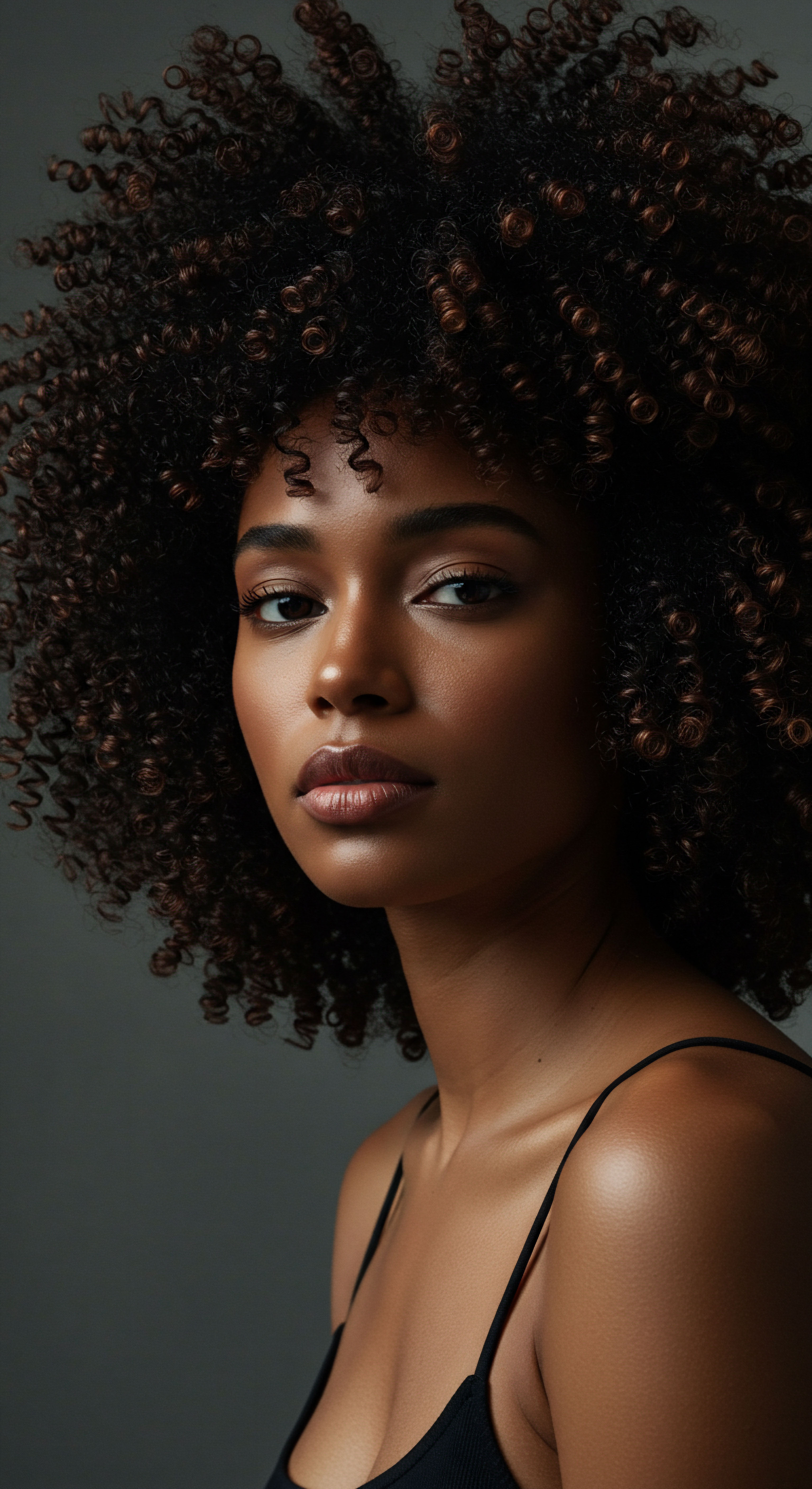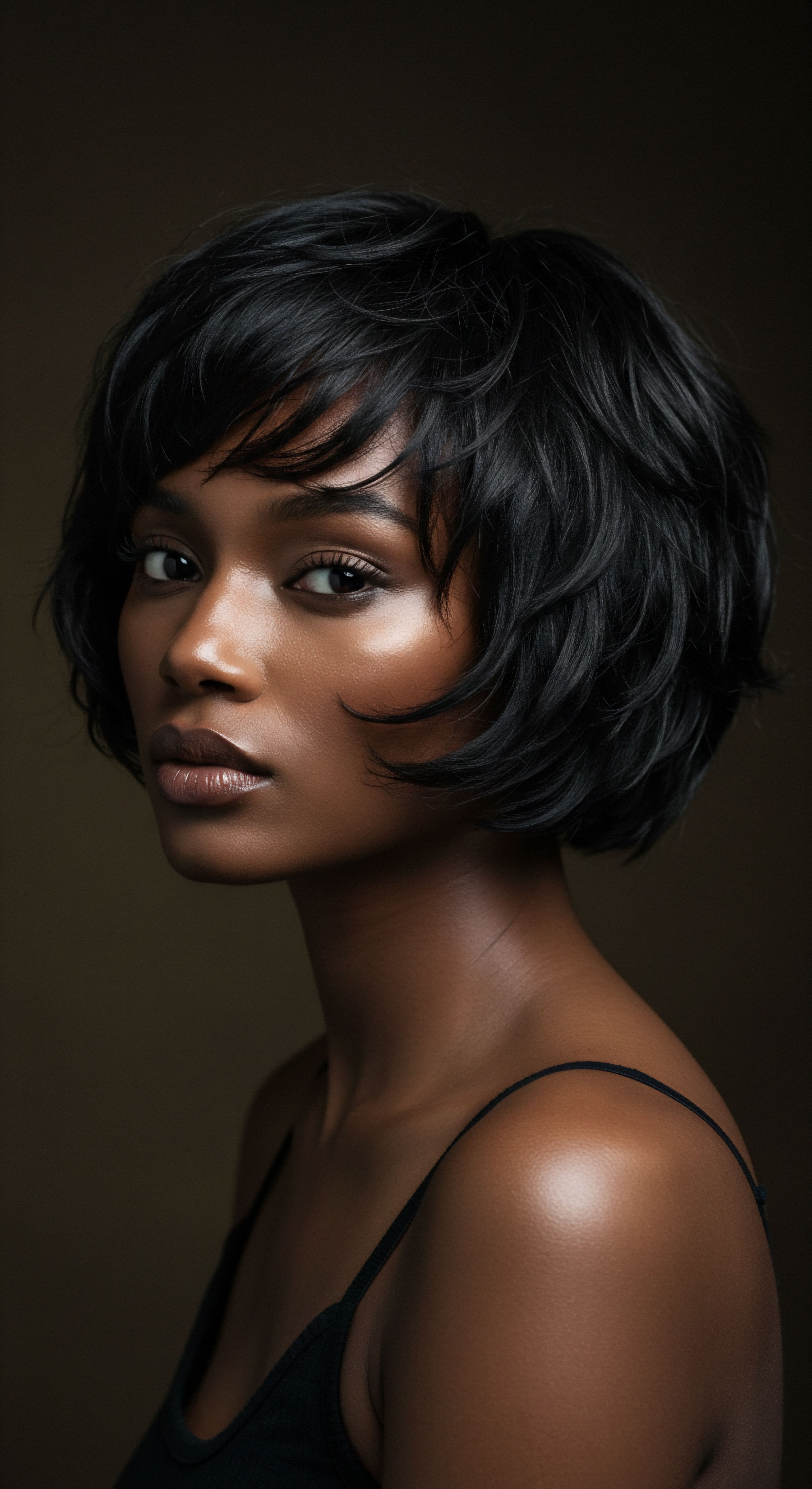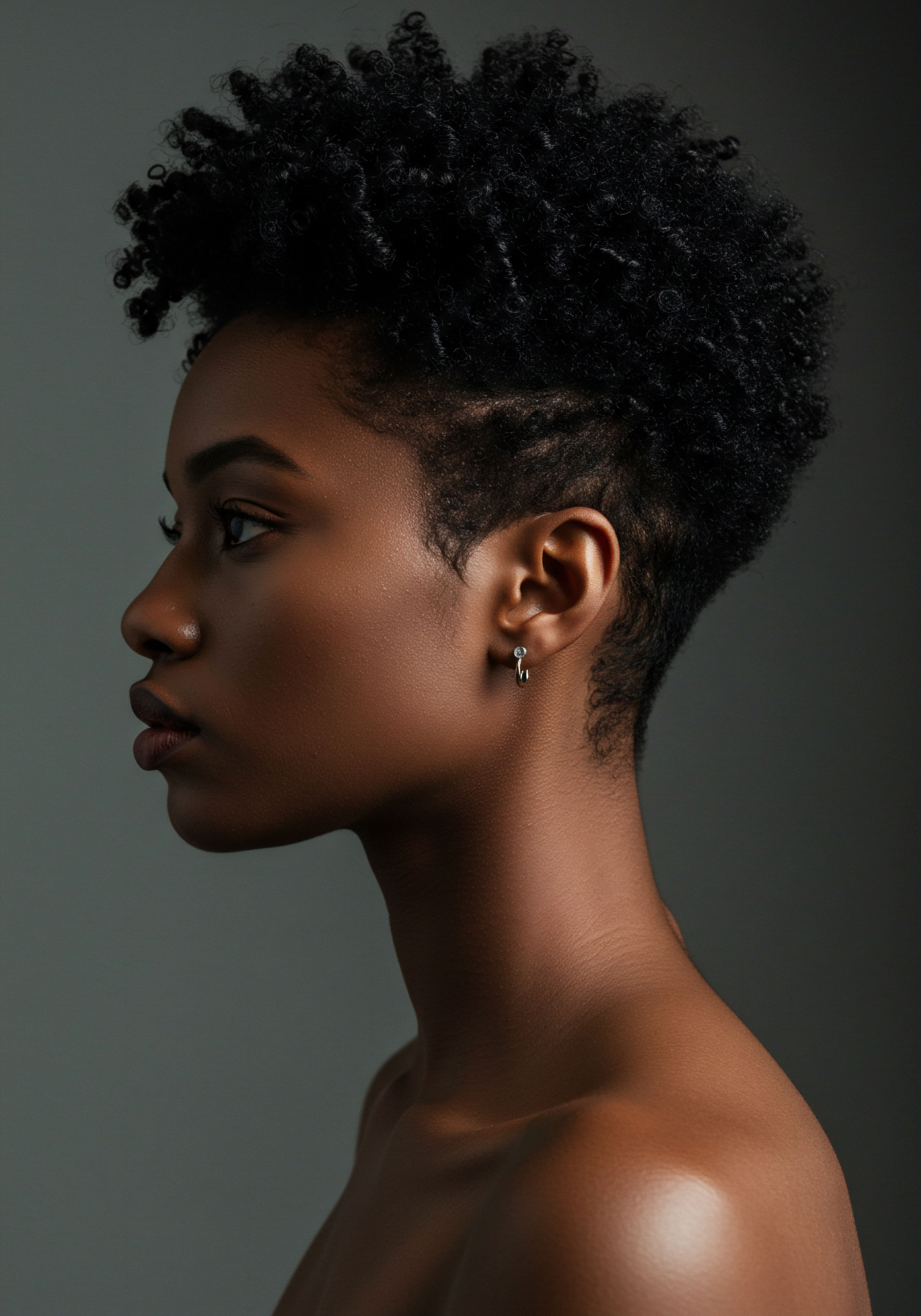The air of the 1960s hummed with a restless energy, a profound yearning for authenticity. Amidst the powerful currents of social and political upheaval, a quiet yet seismic shift began to reshape the very landscape of beauty for Black individuals. It was a time when the unspoken truths of identity, long constrained by societal expectations, began to seek outward expression.
This awakening, often symbolized by the burgeoning natural hair movement, was far more than a simple change in hairstyle; it was a deeply personal and collective reclamation, a visible declaration of self-worth that had been denied for generations. Roothea understands that the journey to understanding this era requires looking beyond the surface, to the deep cultural roots and scientific realities that underpin such transformations.

Roots
The genesis of the natural hair movement in the 1960s cannot be fully appreciated without first acknowledging the profound historical context that shaped Black hair practices for centuries. For individuals of African descent, hair has always held a sacred, symbolic position, far beyond mere aesthetics. In pre-colonial African societies, hair communicated lineage, marital status, age, wealth, and even spiritual connection.
Intricate braiding patterns and styles served as a visual language, a living record of community and identity. This rich heritage, however, faced brutal disruption with the transatlantic slave trade.
The violent severance from ancestral lands stripped enslaved Africans of their cultural practices, including their meticulous hair care rituals. Forced into inhumane conditions, their hair became matted and neglected. Beyond physical hardship, slave owners often shaved the heads of enslaved people, a deliberate act of dehumanization designed to erase their identity and communal bonds. This deliberate act of cultural obliteration laid the groundwork for a beauty standard rooted in subjugation.

How Did Historical Oppression Shape Hair Standards?
Following emancipation, the reverberations of centuries of bondage continued to distort the perception of Black hair. The prevailing Eurocentric beauty ideals, which championed straight, fine hair, became the yardstick against which Black hair was measured and, inevitably, found wanting. Natural hair, with its coils and kinks, was often labeled as “unruly,” “unprofessional,” or even “dirty” by white society, serving as a barrier to employment and social acceptance. This societal pressure led to widespread adoption of hair straightening methods, from hot combs to lye-based chemical relaxers, a practice that gained significant popularity by the mid-1920s.
These processes, while offering a path to perceived societal acceptance, often inflicted physical harm, causing scalp burns and long-term damage, alongside psychological distress. The pursuit of straightened hair became a complex ritual, intertwined with survival and the aspiration for social mobility in a discriminatory world.
The historical subjugation of Black hair, from forced shaving during slavery to the imposition of Eurocentric beauty standards, laid a complex foundation for the 1960s natural hair movement.
The economic landscape also played a part. Figures like Madam C.J. Walker, an African American businesswoman, built an empire by selling hair care products, including those that aided in straightening, becoming the first self-made female millionaire in the U.S.
While her success demonstrated entrepreneurial prowess, some historians view her contributions as perpetuating the idea that straight hair was a prerequisite for social and economic advancement. This historical backdrop of enforced conformity and the economic systems built around it created a deep-seated cultural conditioning, where natural hair was often seen as something to be tamed, altered, or hidden.
The concept of Texturism, a preference for straighter hair textures within the Black community and discrimination against kinkier or curlier textures, also gained traction during this period. This internal hierarchy, a direct consequence of external pressures, meant that individuals with hair closer to Eurocentric ideals often experienced more societal advantages. This painful reality meant that the rejection of one’s natural hair was not merely a personal choice, but a response to systemic pressures and internalized perceptions of beauty.
The tools and practices used to alter Black hair before the 1960s were a testament to the lengths individuals went to conform ❉
- Hot Combs ❉ Heated metal tools, often on a stove, used to press and straighten hair, frequently causing burns.
- Lye-Based Relaxers ❉ Chemical concoctions designed to permanently alter the hair’s protein structure, leading to straight strands but also scalp irritation and potential damage.
- Greases and Oils ❉ Used to slick down and temporarily manage hair, often in combination with heat, to achieve a smoother appearance.
The enduring legacy of these practices and perceptions created a powerful undercurrent of dissatisfaction and a longing for liberation, setting the stage for the dramatic shifts that would characterize the 1960s.

Ritual
Stepping into the 1960s, the rhythm of daily life for many Black individuals was still deeply influenced by the echoes of historical oppression. Hair care, once a source of communal connection and artistic expression in Africa, had become a ritual of concealment and chemical alteration. Yet, amidst this familiar routine, a profound transformation began to stir, prompting a re-evaluation of what constituted beauty and belonging. The emergence of the natural hair movement during this tumultuous decade was not an abrupt, isolated event; it was a conscious, deliberate turning point, a powerful counter-narrative to centuries of imposed standards.

How Did the Civil Rights Movement Catalyze Hair Identity?
The 1960s witnessed the intensification of the Civil Rights Movement, a collective outcry against racial segregation and systemic discrimination. As Black Americans fought for equal rights in public spaces, voting booths, and workplaces, a parallel battle unfolded within the realm of personal identity and self-perception. The movement’s emphasis on racial pride and empowerment, famously encapsulated by the “Black Is Beautiful” slogan, served as a powerful catalyst for a shift in hair aesthetics. This slogan, more than just words, became a declaration, assuring Black individuals that their natural features—skin tone, facial structure, and hair texture—were inherently admirable and beautiful, just as they were.
The adoption of natural hairstyles, particularly the Afro, became a visible symbol of this newfound self-acceptance and a rejection of Eurocentric beauty ideals. It was a public declaration of solidarity and resistance, a way to reclaim an identity that had been suppressed for generations. Prominent activists and cultural figures played a crucial role in popularizing this look.
Angela Davis, with her iconic, voluminous Afro, became a powerful symbol of Black power and rebellion against white American beauty standards. Her image, along with others like Jimi Hendrix and members of The Jackson 5, helped transition the Afro from a political statement to a mainstream trend within the Black community.
The 1960s natural hair movement, deeply intertwined with the Civil Rights and Black Power movements, served as a profound declaration of self-acceptance and a visible rejection of imposed beauty standards.
The decision to wear one’s natural hair was often a deeply personal one, yet it carried immense collective weight. It signified a departure from the assimilationist approach to civil rights, which had often implied conforming to white norms to gain acceptance. Instead, the Afro celebrated Black culture, heritage, and identity, empowering individuals to embrace their roots.
This was not simply a style choice; it was a political act, a statement of defiance against societal norms and a celebration of natural beauty. Even individuals with naturally straighter hair sometimes sought methods to achieve a curlier texture to align with this political stance, using concoctions like vinegar, beer, and Borax cleaner to create a more Afro-like appearance.
The influence extended beyond political rallies and public figures. The shift was observed in everyday life. A 1972 study of Black teens in St.
Louis, while small in scope, revealed that 90 percent of young men and 40 percent of young women sported their natural kinks, a significant increase from earlier decades. This data point, though limited, speaks to a broader national trend of natural hair becoming a prevalent expression of identity within the community.
The impact of the natural hair movement in the 1960s extended to various aspects of Black life ❉
- Cultural Pride ❉ A renewed appreciation for African aesthetics and features, symbolized by the Afro.
- Political Resistance ❉ A visible rejection of systemic racism and a statement against oppression and discrimination.
- Self-Acceptance ❉ A move away from internalized racism and the psychological burden of conforming to external beauty ideals.
This period marked a turning point where hair became a powerful tool for self-expression and a symbol of rebellion, identity, and solidarity, laying down a foundation for future generations to build upon.

Relay
As the vibrant spirit of the 1960s permeated society, the natural hair movement ascended beyond a mere aesthetic shift, evolving into a complex interplay of cultural reawakening, psychological liberation, and political assertion. It was a time when the very strands of hair became a conduit for deeper conversations about race, power, and self-determination. This era challenged prevailing societal structures, forcing a re-evaluation of what was considered “acceptable” and “beautiful,” particularly for Black Americans.

What Were the Societal and Psychological Repercussions of Hair Discrimination?
The deeply ingrained societal preference for straight hair before the 1960s was not without significant psychological cost. Generations of Black individuals were conditioned to view their natural hair as undesirable, a perception often reinforced by family and broader media. Research from TRIYBE, a contemporary knowledge resource, highlights that such historical messaging contributes to internalized racism and negative self-image among Black individuals. The pressure to chemically straighten hair to avoid discrimination, a process often physically and psychologically damaging, became a normalized expectation.
For instance, a 2023 survey study indicated that Black respondents reported the most frequent use of chemical straighteners compared to other racial groups, with 61% stating they used them because they “felt more beautiful with straight hair”. This statistic, while from a later period, speaks to the enduring legacy of beauty standards established long before the 1960s, illustrating the deep psychological conditioning the movement sought to undo.
The act of wearing an Afro or other natural styles in the 1960s was, therefore, an act of profound courage and self-affirmation. It was a direct challenge to the notion that professionalism and respectability were tied to Eurocentric appearances. Those who chose natural hair often faced opposition, being labeled “militant” or “threatening” by law officials, politicians, and the media. This perception underscores how deeply hair was intertwined with political ideology and the anxieties of mainstream society concerning Black liberation.
| Era/Practice Pre-Colonial Africa |
| Dominant Hair Trend Diverse natural styles (braids, twists) |
| Societal Message Status, community, spiritual connection |
| Impact on Identity Affirmation, cultural continuity |
| Era/Practice Slavery & Post-Emancipation |
| Dominant Hair Trend Forced shaving, later straightened styles |
| Societal Message Dehumanization, assimilation, inferiority |
| Impact on Identity Loss, internalized negativity, desire to conform |
| Era/Practice Early 20th Century |
| Dominant Hair Trend Hot combs, chemical relaxers gain popularity |
| Societal Message "Good hair" equals straight, middle-class status |
| Impact on Identity Economic pressure, physical harm, self-hatred |
| Era/Practice 1960s Natural Hair Movement |
| Dominant Hair Trend Afro, natural kinks, coils |
| Societal Message Black is beautiful, pride, resistance |
| Impact on Identity Reclamation, empowerment, political statement |
| Era/Practice The evolution of Black hair practices reflects a continuous negotiation between cultural heritage and external pressures. |

How Did the Natural Hair Movement Shift the Cultural Dialogue?
The natural hair movement shifted the cultural dialogue by directly confronting the historical narrative that had pathologized Black hair. It presented a counter-narrative of beauty, strength, and inherent worth. The movement coincided with the rise of the Black Power movement, where self-definition and self-reliance became paramount. Hair became a canvas for this ideology, transforming from a site of oppression into a symbol of freedom and self-expression.
This shift also influenced the burgeoning Black media landscape. The June 1966 edition of Ebony magazine, for example, featured “The Natural Look,” signaling a significant aesthetic change and bringing natural hair into a prominent cultural spotlight. This media visibility, though nascent compared to today’s digital age, played a vital role in normalizing and celebrating textured hair within the community, offering counter-images to the pervasive Eurocentric ideals.
The movement was not solely about appearance; it was about asserting a collective identity and challenging the very foundations of racial hierarchy. It laid the groundwork for future legal battles against hair discrimination, such as the CROWN Act, which decades later would seek to codify protections for natural hairstyles in workplaces and schools.
The natural hair movement in the 1960s served as a profound psychological and cultural counter-narrative, challenging centuries of internalized racism and societal discrimination against Black hair.
The impact of the natural hair movement extended into several spheres ❉
- Legal Realm ❉ Although not immediately, the movement set the stage for future legal protections against hair discrimination, influencing discussions around Title VII of the Civil Rights Act regarding workplace appearance.
- Beauty Industry ❉ It prompted a slow but eventual recognition of the specific needs of textured hair, leading to the development of products tailored for natural curls and coils, rather than solely for straightening.
- Global Influence ❉ The visual statement of the Afro resonated beyond the United States, inspiring similar expressions of Black pride and cultural identity in diasporic communities worldwide.
The prominence of the natural hair movement in the 1960s was thus a multifaceted phenomenon, a powerful convergence of historical reckoning, political activism, and a deep-seated human desire for self-acceptance and authentic expression. It marked a pivotal moment in the ongoing journey toward defining Black beauty on its own terms.

Reflection
The whisper of change that began in the 1960s, a gentle insistence on authenticity, continues to resonate today. The natural hair movement, born from a confluence of historical struggle and a burgeoning sense of self, peeled back layers of imposed beauty standards, revealing the radiant truth of textured hair. It was a powerful, collective breath, allowing Black individuals to stand in their inherent beauty, unbound by expectations.
This journey of reclamation reminds us that beauty is not a monolithic ideal, but a diverse, ever-unfolding landscape of self-expression, deeply connected to heritage and personal liberation. The echoes of that era remind us that the most profound acts of defiance often begin with the quiet courage to simply be oneself.

References
- Griffin, Chanté. “How Natural Black Hair at Work Became a Civil Rights Issue.” JSTOR Daily, 2019.
- Byrd, Ayana, and Lori Tharps. “Hair Story ❉ Untangling the Roots of Black Hair in America.” St. Martin’s Press, 2001.
- Kimbell, Regina. “My Nappy Roots ❉ A Journey Through Black Hair-itage.” Documentary Film, 2004.
- Ladner, Joyce A. “Tomorrow’s Tomorrow ❉ The Black Woman.” Doubleday, 1971.
- Rooks, Noliwe M. “Hair Raising ❉ Beauty, Culture, and African American Women.” Rutgers University Press, 1996.
- Walker, A’Lelia Bundles. “On Her Own Ground ❉ The Life and Times of Madam C. J. Walker.” Scribner, 2001.
- Byrd, Ayana D. and Lori L. Tharps. “Hair Story ❉ Untangling the Roots of Black Hair in America.” St. Martin’s Press, 2014.
- Tharps, Lori L. “Hair Story ❉ Untangling the Roots of Black Hair in America.” St. Martin’s Press, 2001.
- Caldwell, Paulette. “A Hair Piece ❉ Perspectives on the Regulation of Black Women’s Hair.” Duke Law Journal, 1991.
- Ellis-Hervey, N. et al. “African American Women’s Perceptions of Beauty and the Wearing of Hair.” Journal of Black Psychology, 2016.
- Robinson, Stephanie. “Black Hair ❉ Art, Culture, History, and Style.” Universe, 2011.
- Opie, T. & Phillips, K. “The Psychological Impact of Hair on Black Women.” Journal of Black Studies, 2015.
- Singh, R. & Singh, A. “Beauty and the Beast ❉ The Psychological Impact of Beauty Standards.” International Journal of Psychology and Counseling, 2011.
- Kelley, Robin D. G. “Race Rebels ❉ Culture, Politics, and the Black Working Class.” Free Press, 1997.
- Lester, Neal A. “The History of African American Hair.” University of Texas Press, 2000.